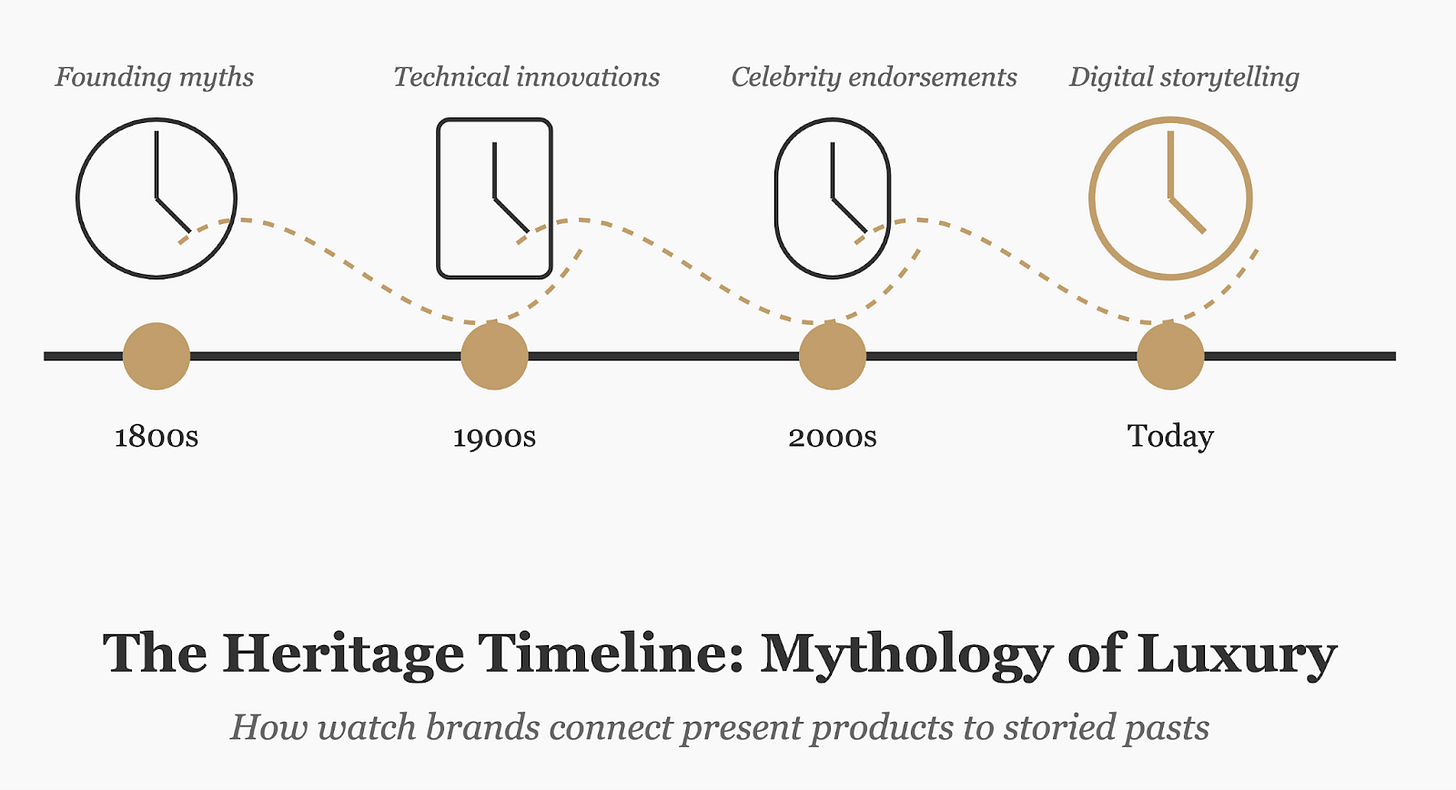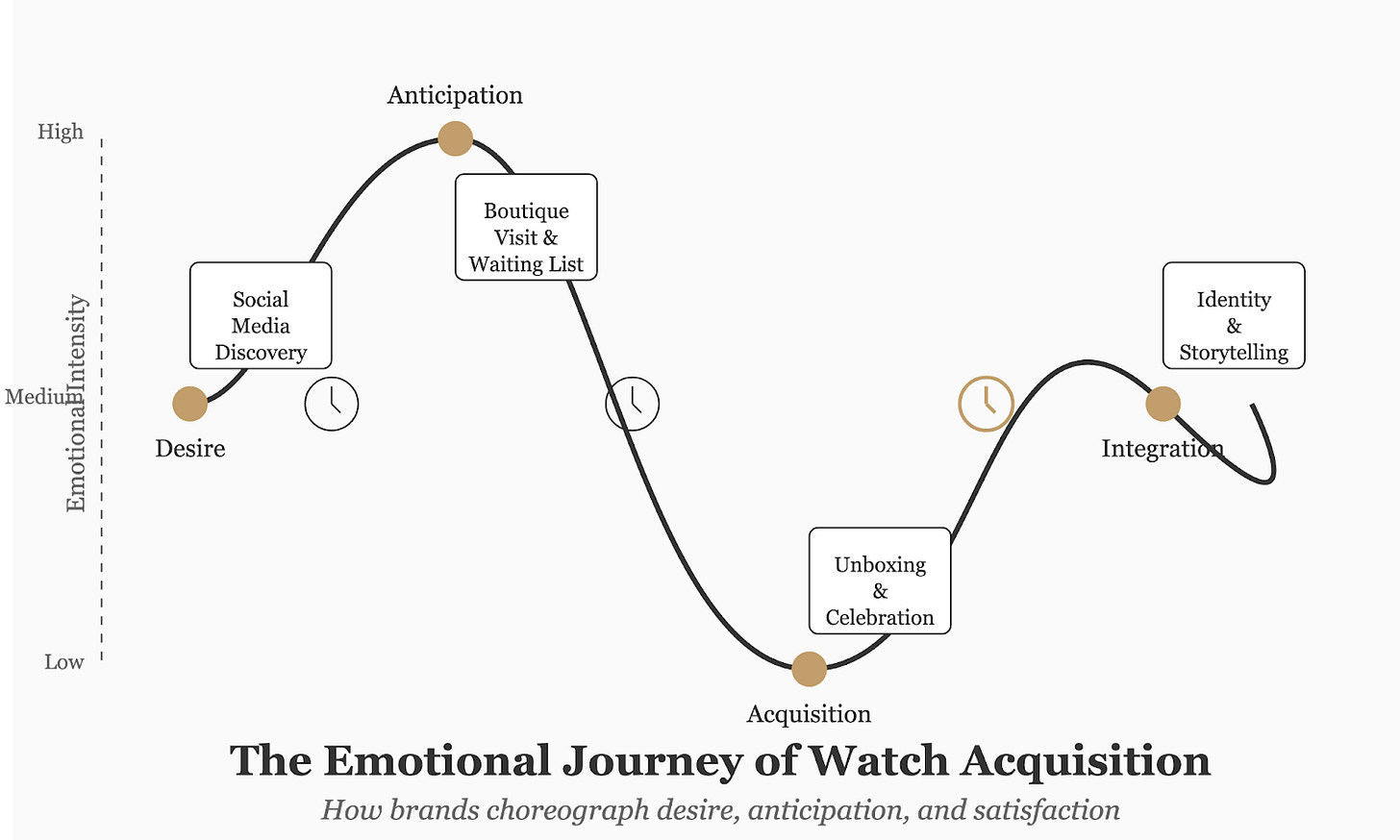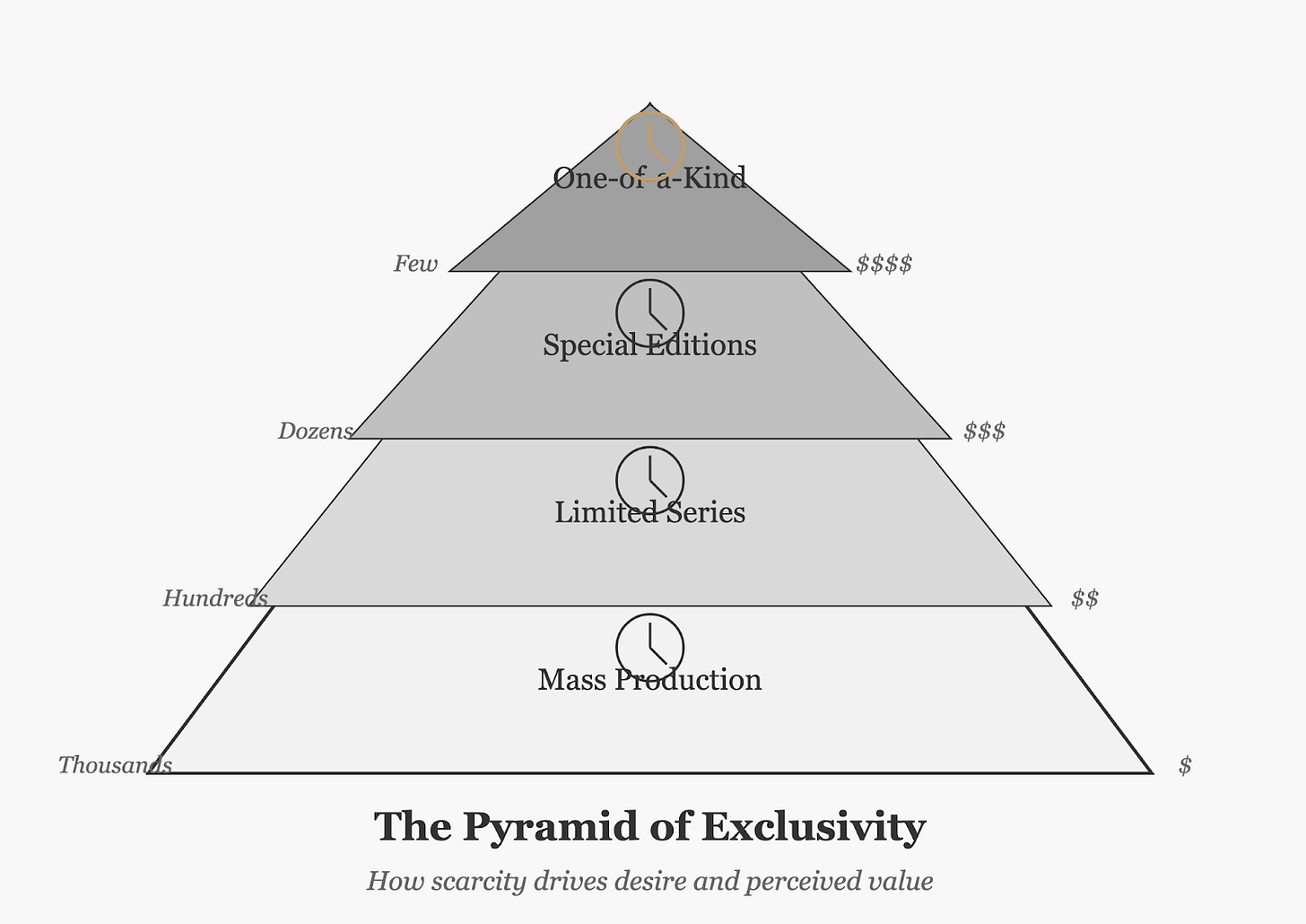The Luxury Watch Game
“It is the preoccupation with possessions, more than anything else, that prevents us from living freely and nobly." — Bertrand Russell
In an age where time is displayed on every digital device we own, the luxury mechanical watch industry continues to thrive—not because its products tell time better but because it has mastered the art of selling something far more valuable: identity, heritage, and exclusivity. This essay examines the sophisticated brand strategies that transform functional timepieces into coveted symbols of status and personal achievement.
The Mythology of Heritage
The luxury watch industry's most potent weapon is storytelling. Brands like Patek Philippe, Rolex, and Audemars Piguet do not merely sell watches; they sell carefully curated narratives that span generations. These stories transform the purchase from a transaction into an induction into a lineage of excellence.
When customers purchase a Patek Philippe, they are not just buying gears and springs; they are buying into the mythology of craftsmen working in the Swiss mountains for generations, perfecting their art. The brand's famous tagline—"You never actually own a Patek Philippe. You merely look after it for the next generation"—elevates a watch from accessory to heirloom, connecting the owner to both past and future.
This historical narrative creates an emotional resonance that transcends the physical product. Many luxury brands emphasize their founding dates, royal warrants, and technical innovations as historical facts and evidence of their legitimacy in a marketplace where newcomers are viewed with skepticism.
The Journey as Product
For luxury watch brands, the purchasing experience itself has become a crucial part of the product. The journey from first consideration to ownership is meticulously designed to reinforce exclusivity and make the eventual acquisition feel like an achievement rather than a mere purchase.
The watchmaker Hublot exemplifies this approach. Potential customers often face waiting lists for popular models, are invited to private events, and experience personalized service that makes them feel part of an elite club even before they own the product. This "journey" creates anticipation and investment that amplifies the emotional payoff when the watch is finally secured.
Brand flagships stores are designed as temples to craftsmanship, with reverent displays, hushed atmospheres, and attentive staff who treat even browsing customers as connoisseurs. This experience stands in stark contrast to the utilitarian transaction of buying a standard timepiece, reinforcing the notion that luxury watches exist in a different category altogether.
Manufacturing Scarcity in an Age of Abundance
Perhaps the most transparent yet effective strategy luxury watch brands employ is the careful management of scarcity. In an era where technology enables mass production of nearly anything, luxury watch brands deliberately limit their output to maintain exclusivity.
Rolex has perfected this strategy. Despite having the capacity to produce many more watches, they carefully restrict supply, creating infamous waiting lists for models like the Submariner and Daytona. This manufactured scarcity creates a secondary market where some models command prices far above retail, reinforcing their desirability and investment value.
Limited editions serve as the purest expression of this strategy. When Omega releases a James Bond edition or Audemars Piguet creates a Royal Oak variant limited to 50 pieces, they're not responding to production constraints but deliberately creating collectibles whose value is tied directly to their rarity.
This strategy transforms customers into hunters, giving them stories of pursuit to share alongside their prized acquisition. The journey of securing a rare Rolex or limited-edition Omega becomes part of the watch's personal history for its owner, adding layers of meaning beyond the physical object.
Digital Exclusivity: Social Media's Paradoxical Role
Social media has created a fascinating paradox for luxury watch brands. These platforms democratize access to information and images of exclusive products, potentially diluting their mystique. Simultaneously, they create new brand opportunities to reinforce exclusivity through carefully curated content.
Instagram has become particularly important in the luxury watch ecosystem. Brands use it to showcase their heritage through archival images, highlight craftsmanship through workshop videos, and associate themselves with aspirational lifestyles. They carefully select influencers and celebrities whose narratives align with the brand's positioning.
For consumers, social media provides a venue to display their horological acquisitions, translating the physical status symbol into digital social capital. The hashtag #wristshot has become a recognized genre of social content, allowing watch owners to signal their taste and financial achievement subtly.
However, this visibility creates challenges. Brands must balance exposure with exclusivity, ensuring their products remain visible enough to be desired but not so common as to seem ordinary. This delicate balance requires sophisticated social media strategies that communicate exclusivity even as they broadcast to millions.
The Emotional Economics of Collecting
At the heart of luxury watch branding lies an understanding of collecting psychology. Watch brands recognize that rational economic decision-making rarely drives purchases at the high end of the market. Instead, emotional connections and personal identity formation drive acquisition decisions.
Luxury watches serve as physical manifestations of personal milestones. A Rolex purchased to mark a promotion, an Omega commemorating a wedding, or a Patek celebrating the birth of a child—each becomes imbued with personal significance that transcends its market value.
Brands deliberately foster these associations through advertising emphasizing life achievements rather than product features. The message is clear: the watch is not merely a purchase but a marker of personal history, a physical totem of accomplishment that can be worn and displayed.
This emotional connection creates powerful brand loyalty. A collector's first luxury watch often establishes a relationship with the brand that leads to subsequent purchases, reinforcing the collector's identity as a connoisseur of that particular maker.
Conclusion: The Future of Luxury Watch Branding
As we look to the future, luxury watch brands face challenges and opportunities. Digital technology threatens the functional relevance of mechanical timepieces while simultaneously creating new platforms for storytelling and community building.
The most successful brands will continue emphasizing what makes their products uniquely valuable in a digital age: tangibility, craftsmanship, and permanence. They will leverage digital platforms as marketing channels and extensions of the exclusive communities they have built around their products.
The fundamental brand strategies—storytelling, journey creation, scarcity management, and emotional connection—will remain powerful tools, albeit adapted for changing cultural contexts. The luxury watch industry has survived quartz technology, economic recessions, and changing fashion trends by understanding that it sells far more than timekeeping devices.
In an era of disposable technology and ephemeral digital experiences, the enduring appeal of mechanical watches reminds us that humans still value objects that combine beauty, history, and permanence. Luxury watch brands don't just tell time—they tell stories about who we are, what we value, and how we wish to be remembered. That narrative power ensures their relevance long after the functional necessity of wearing a watch has faded.
Author: Sergio Galanti





